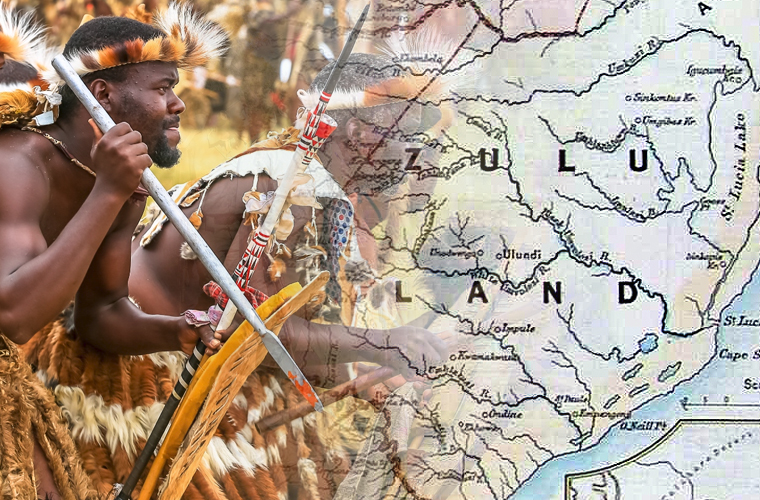Zululand, located in the northeastern part of present-day KwaZulu-Natal province, South Africa, is the traditional homeland of the Zulu people and the heart of their 19th-century kingdom.
The Zulu, a Nguni group, originated as a small chieftaincy near the White Mfolozi River. In the 1810s and early 1820s, they grew into a powerful kingdom through alliances with neighboring chieftaincies. The nearby Mthethwa confederacy, led by Dingiswayo (1809–1817), forged close ties with the Zulu. After Dingiswayo’s death, Shaka (1816–1828) assumed leadership, transforming the Zulu into a dominant force. Using a disciplined army organized into amabutho (age-based regiments, a tactic learned from the Mthethwa), Shaka expanded the kingdom from the Mzimkhulu River in the north to the Tugela River in the south, and from the Drakensberg mountains to the coast. He established fortified settlements called amakhanda to defend against raids and protect refugees.
Shaka was assassinated in 1828 and succeeded by his half-brother Dingane (1828–1840). During Dingane’s reign, the kingdom faced incursions by the British and Boers, who allied with Dingane’s brother, Mpande. In 1840, Mpande overthrew Dingane, who was later killed. Under Mpande (1840–1872), the Boers and British seized parts of the Zulu territory. The Boers took land south of the Black Mfolozi, but the British, after annexing Natal in 1843, forced them to return the core region between the Black Mfolozi and Tugela rivers to the Zulu.
Mpande’s son, Cetshwayo (1872–1879), resisted British dominance, leading to the Anglo-Zulu War of 1879. After an early Zulu victory at Isandlwana, the British captured Cetshwayo’s capital, Ulundi, in July, and him in August, dividing the kingdom into 13 chieftaincies. In 1882, the British designated the southern part between the Mhlatuze and Tugela rivers as the Zulu Native Reserve. Cetshwayo returned to Ulundi in 1883 but faced civil war from rival Zulu factions. On July 21, 1883, his defeat in the second Battle of Ulundi marked the end of the independent Zulu kingdom. Large areas were ceded to the Boers, forming the New Republic in the southeastern Transvaal.
In 1887, the British annexed the remaining Zululand outside the Native Reserve and New Republic, creating the British Colony of Zululand. Cetshwayo’s son, Dinuzulu, was exiled to St. Helena in 1888 for resisting this annexation. In 1897, British Zululand was incorporated into Natal, which gained self-government in 1893. After the Boer defeat in the South African War (1899–1902), the New Republic was also absorbed into Natal. Between 1902 and 1904, a Land Commission allocated two-thirds of Zulu land, including fertile regions, to non-Zulus. The Bambatha Rebellion of 1906 crushed the last Zulu resistance, driven by heavy taxation and land loss. The remaining Zulu areas became Native Reserves, governed by chiefs under white administrators. Population growth and land competition in these reserves heightened ethnic identity, with many claiming “Zuluness” despite no ancestral ties to the original kingdom.
In 1910, Natal joined the Union of South Africa. Under apartheid’s 1959 Promotion of Bantu Self-Government Act, the scattered Zulu reserves, along with other African areas in southern Natal and northern Transkei, were designated as the KwaZulu “Homeland” or Bantustan to exclude black Africans from South African politics. The KwaZulu Territorial Authority (1970) and Legislative Assembly (1972) were established, but Mangosuthu Buthelezi, leader of KwaZulu and the Inkatha movement, rejected full independence, choosing to work within the Bantustan system to oppose apartheid. In 1994, with apartheid’s end, KwaZulu merged with Natal to form KwaZulu-Natal province.

